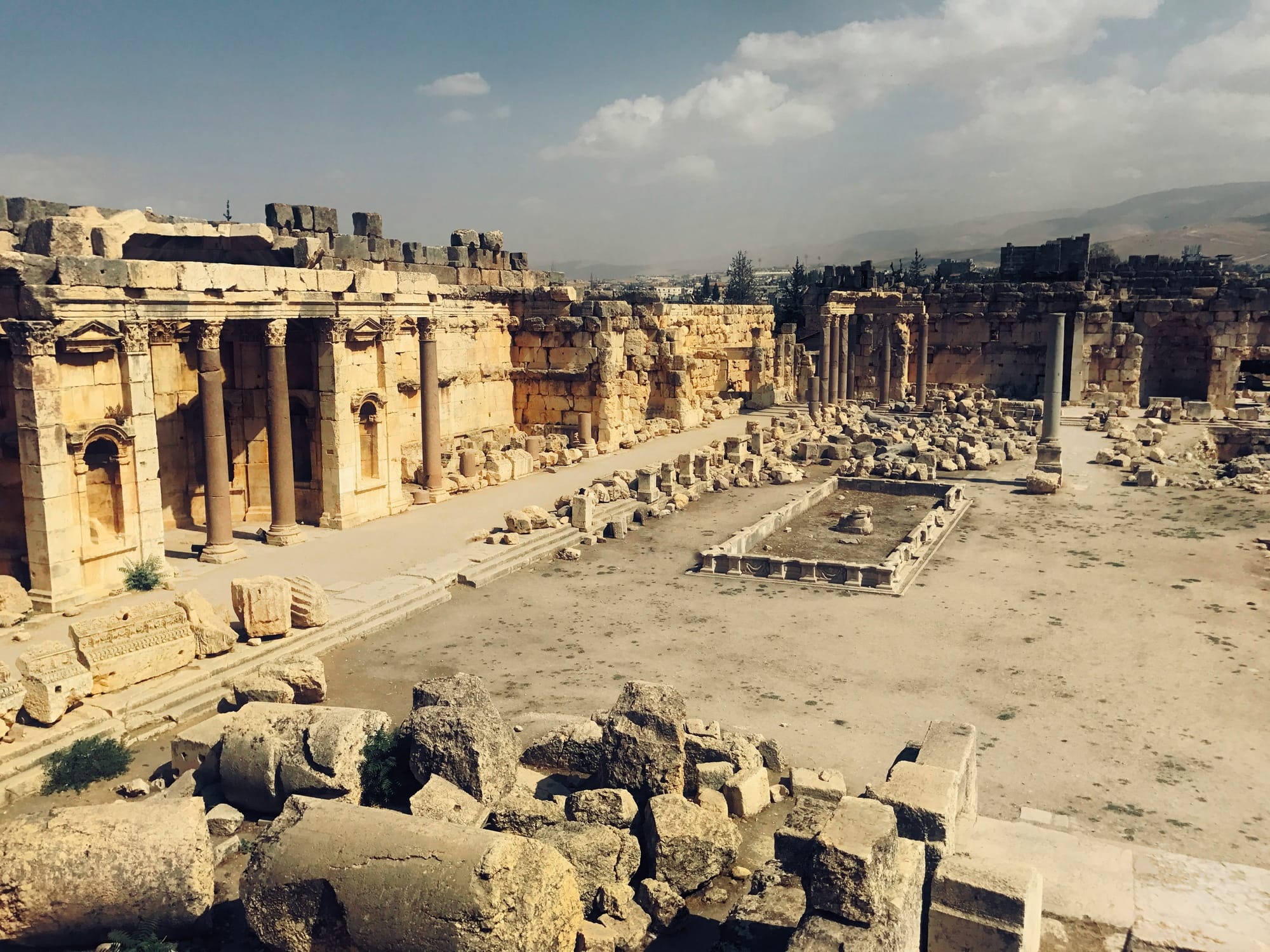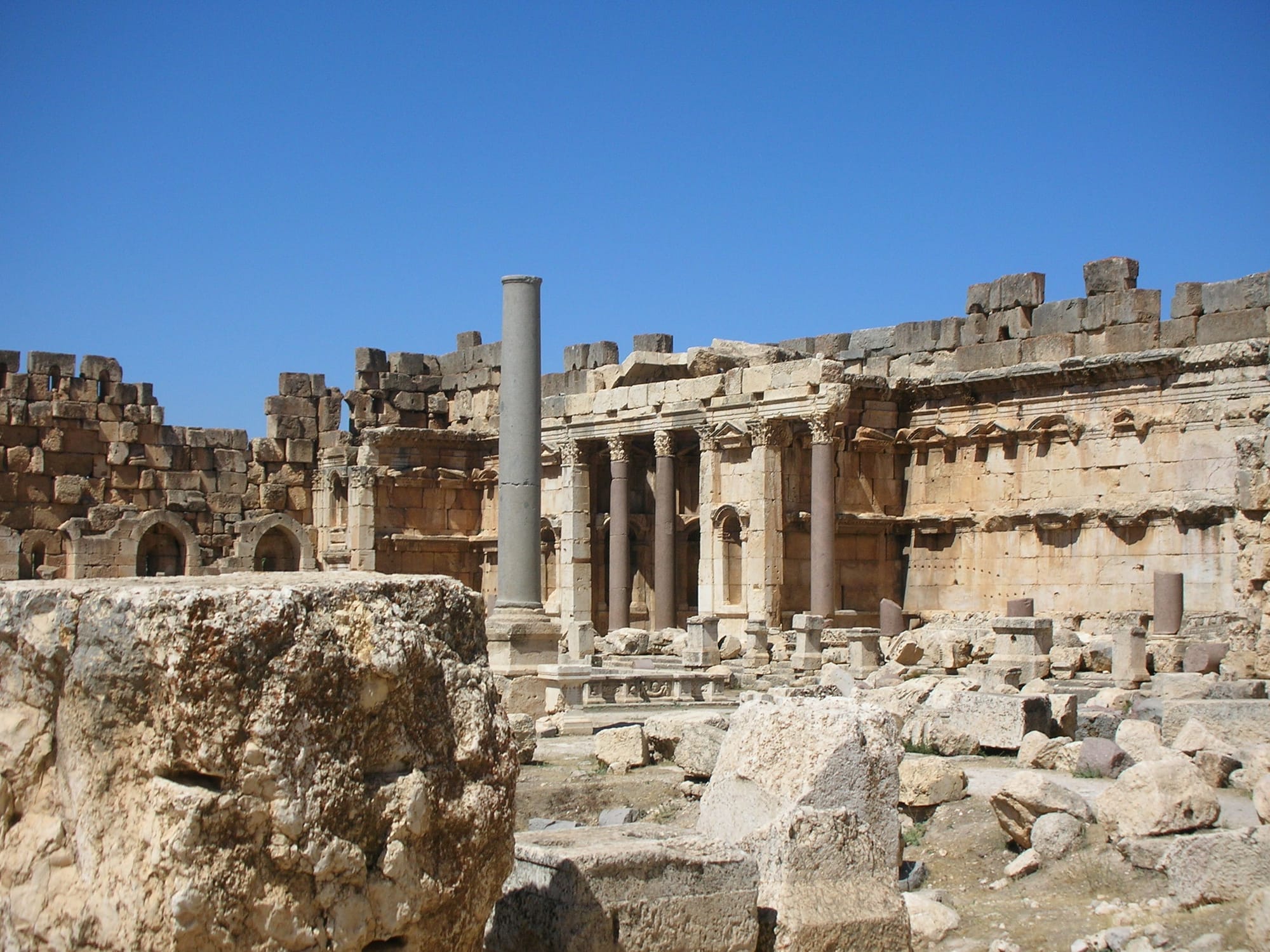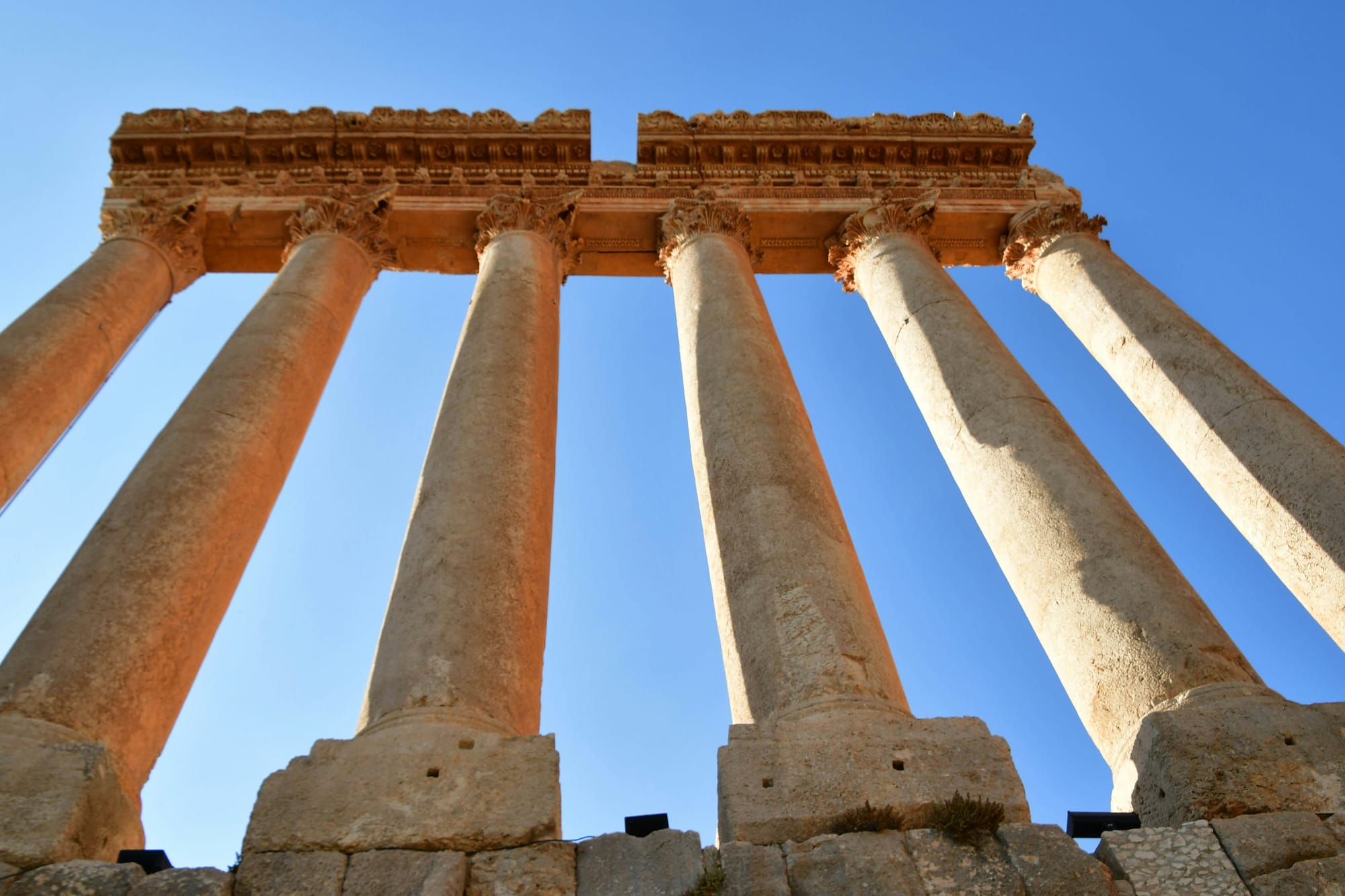The Largest Temple of the Roman world: The Temple of Jupiter in Baalbek
The Temple of Jupiter at Baalbek, also known as Heliopolis Syriaca, is a massive Roman temple and known as the largest of its kind in the Roman Empire.

Located at the western end of the Great Court of Roman Heliopolis, the temple of Jupiter's exact commissioning, design, and construction dates remain unknown. It stands on a broad stone platform elevated an additional 7 meters (23 feet) above the foundation's gigantic stones, three of which rank among the heaviest blocks ever used in construction.
Its columns, known as the largest columns of the Roman era, stood 19.9 meters high and had a diameter of nearly 2.5 meters, making them also the largest in the classical world. The construction of this colossal temple complex spanned three centuries.
These columns rest on a podium constructed from what are believed to be the largest blocks ever utilized in a building, each measuring 4 by 4 by 20 meters. The site had long been a place of cultic activity, suggesting the temple likely replaced an earlier one, possibly utilizing the same foundation.

Digging in the chests of history
The temple of Jupiter in Baalbek, Lebanon, was known in ancient times as Heliopolis (Greek: Ηλιούπολη=City of the Sun). The construction of the Temple of Jupiter began around the 1st century BCE and continued into the 3rd century CE during the Roman Empire's zenith.
This massive temple, was dedicated to a deity referred to at different times as Ba’al, Hadad, Helios, Zeus, or Jupiter Optimus Maximus Heliopolitanus. Macrobius notes that the cult statue, taken from Egypt and made of gold, depicted the god as a youthful, beardless man with his right hand raised holding a whip like a charioteer, and his left hand holding a lightning bolt and ears of grain.
“But this is known to be the same Jove and the sun, both from the sacred rite itself and from his habit: for the golden simulacrum of a bearded man stands with his right hand raised with a flame in the manner of a charioteer, and his left hand he holds lightning and spikes, all of which show the power associated with Jupiter and the sun.” (Macrobius, Saturnalia)
The statue was flanked by two bulls, Hadad’s sacred animal, and featured representations of the Sun and Moon on its chest, with a basket-shaped hat, or kalathos, on its head. The god of Heliopolis embodied many roles: fertility god, lord of thunder and rain, oracular god, and supreme deity, also serving as a sun god, which may explain the temple’s eastward orientation. This temple, the largest in the Roman world, functioned as an oracle. In 114 CE, the god predicted that Emperor Trajan would not return from his campaign against the Parthian Empire.
“They consulted this god, and those who were absent sent letters sealed: and he wrote back in order to those things which were added to the consultation. Thus the emperor Trajan, about to enter Parthia from that province with an army of the most steadfast religion, exhorting his friends, who had taken the greatest experiments of this deity, to consult about the outcome of the thing begun, he acted according to the Roman counsel, first examining the faith of religion, lest it might be subject to human fraud: and first he sent signed codicils to which he wished to be rewritten for himself”. (Macrobius, Saturnalia)

This is one of only two known pronouncements from the Baalbek oracle; the other involved columns cut for Baalbek that were reportedly lost at sea near Berytus.
“An oracle given in Heliopolis when the Ship was lost containing the columns of the temple of Zeus there, which are now in Berytus." (Palatine Anthology)
Macrobius describes that during oracle sessions, the statue was placed in a litter, and the bearers would sense the divine will and move in certain directions, which the priests interpreted. A similar practice was used at the oracle of Ammon in Siwa, Egypt. (Baalbek: Temple of Jupiter in Ancient Rome, by Jona Lendering, historian)
“The religion of this temple also predominates in divination, which refers to the power of Apollo, who is the same as the sun. For the simulacrum of the Heliopolitan god is carried on a plate , just as the simulacrums of the gods of the Circus are ridden in the parade of the games of the Circus to give answers." (Macrobius, Saturnalia)

Just 40 meters south of the temple of Jupiter, stands the somewhat smaller yet exceptionally well-preserved Temple of Bacchus. Despite Heliopolis being no more than a modestly sized town, neither a bustling caravan city nor a central hub on a major trade route, the presence of such enormous temples remains a mystery.
The early history of Heliopolis is shrouded in mystery. It first emerges from obscurity in Strabo's account of the events of 64 BCE, written around the beginning of the Common Era.
“At no great distance also were Heliopolis and Chalkis, subject to Prolemy the son of Mennaios, who possessed Massyas and the mountainous country of the lturaeans.”
Both ancient and modern observers often credit the Ptolemies of Egypt with founding Heliopolis. However, it is equally plausible that Seleucid kings, following their conquest of the Levant under Antiochos III around 200 BCE, were its founders.
Given the lack of concrete evidence, one might even speculate that the founder of Heliopolis was the Ptolemy mentioned by Strabo, the Ituraean tetrarch who governed the Beqa' in the first century BCE. Another Ituraean foundation, their nearby capital, also bears a Greek name, Chalkis. (Contextualizing the sacred Elizabeth Frood, University of Oxford,Rubina Raja, Aarhus Universitet)

The story of the Temple of Jupiter
Baalbek rose to prominence during the late Hellenistic era, becoming the sacred town for the Ituraean tetrarchs of Chalcis in the 1st century B.C. It thrived under the Roman Empire as a colony and was a pagan stronghold during the Byzantine period.
Conquered by Muslims in 637 A.D., the sanctuaries were converted into a fortress, and some columns were later taken to Istanbul by Sultan Suleiman the Magnificent for his mosque. An earthquake in 1759 further damaged the ruins. Recognized since the 17th century, the site includes the grand sanctuary of Heliopolitan Jupiter and the adjoining Temple of Bacchus.
The construction likely began under Augustus, with further expansions over three centuries. The site features vast dimensions and elaborate decorations, blending Roman architectural styles with ancient Oriental elements. The complex is built on an enlarged ancient mound with massive terrace works and vaulted galleries. The main temple, surrounded by towering columns and adorned with intricate designs, stands as a testament to the engineering prowess of the era.
The temple complex includes a massive platform measuring approximately 88 meters long and 48 meters wide, supported by some of the largest stone blocks ever used in construction, known as the "Baalbek Trilithon." These stones weigh up to 800 tons each. The construction is dated by a graffito left by one of the stonemason teams on top of a column shaft in the temple pronaos. This graffito dates to 2 Loos 371, corresponding to August 2, 60 CE.

The well-preserved Antonine period temple, often referred to as the Temple of Bacchus, is located south of the Temple of Jupiter on a high podium. It features an 8 by 15 unfluted Corinthian column peristyle and an elaborately decorated interior with sculpted stone ceilings showcasing mythological scenes. The cella is accessed through a large, intricately carved door, adorned with vine scrolls and kantharoi.
Inside, the cella includes Corinthian columns and sculpted friezes depicting the legend of Dionysos. The temple served as a site for mystery and initiation ceremonies. Other notable structures include a small 3rd-century temple, a colonnade with a Syrian arch, a potential council hall or Senate, and remnants of a hippodrome and theater.
Additionally, a statue of a Roman empress, a temple of Venus, mosaic floors in nearby villas, and a Roman gate with a Hercules figure have been discovered in the area. The medieval ramparts run parallel to the great sanctuary's axis, and the necropoleis remain largely unexcavated.
The Ptolemaic rulers of the Bekaa Valley in the third century BCE likely initiated the construction of the platform for the Temple of Jupiter, with work continuing over the centuries. The shrine itself began around 60 BCE and was largely completed during Nero’s reign (54-68 CE), becoming renowned worldwide.
Emperor Antoninus Pius, began building the Great Court in front of the Temple of Jupiter. Celebrations were impressive enough that, centuries later, Antiochene chronicler John Malalas credited Antoninus with building all of Heliopolis. Subsequent rulers, such as Septimius Severus and his son Caracalla, added the Propylaea, while Philip the Arab completed the Hexagonal Court.
This made it one of the largest temples globally, and certainly the largest in the Roman world. The temple incorporated elements from various cultures, such as a sacred room and “holy of holies” from Near Eastern tradition, and Corinthian architectural styles from Greek tradition. The symmetrical expansion along the axis was reminiscent of Egyptian temples.

With the rise of Christianity, the temple and its oracle declined. Emperor Theodosius I likely closed the temple, while his grandson Theodosius II, constructed a basilica on the Great Court, possibly covering the Hexagonal Court with a dome, resembling the Basilica of the Holy Sepulcher in Jerusalem. According to ps.-Zacharias of Mytilene, the temple was destroyed by lightning in 524/525 CE.
“The temple of Solomon in the city of Heliopolis in the forest of Lebanon, as to which Scripture mentions that Solomon built it and stored arms in it, was burnt.
And to the south of it are three wonderful stones, on which nothing is built, but they stand by themselves, joined and united together and touching one another; and all three are distinguished by effigies, and they are very large. And in a mystical sense they are set, as it were, to represent the temple of the knowledge of the faith in the adorable Trinity, the calling of the nations by the preaching of the gospel tidings.
There came down lightning from heaven, while the rain fell in small quantities: it struck the temple and reduced its stones to powder by the heat, and overthrew its pillars, and broke it to pieces and destroyed it. But the three stones it did not touch, but they remain perfect; and now a house of prayer has been built there, dedicated to Mary the Holy Virgin, the Theotokos.”
Zacharias of Mytilene, Ecclesiastical History
Ironically, the temple dedicated to a lightning god perished this way. The same author notes that by his time, the temple had been converted into a church dedicated to Mary, Mother of God. Emperor Justinian, removed some granite columns for use in the Hagia Sophia in Constantinople. After the Arab conquest, the church in the ancient sanctuary was abandoned and later dismantled. During the Crusades, the complex was converted into a fortress, now known as Qalaa, meaning “fort.”

The Great Court
The Great Court of the Temple of Jupiter in Baalbek is a significant structure, measuring 135 by 113 meters, about a third the size of the Temple of Ba'al's court in Palmyra. It is surrounded on three sides by porticoes, with a grand staircase on the west leading to the shrine. Inside the court are two basins, two tower-altars, and two free-standing columns, built on an ancient hilltop dating back to the Chalcolithic period.
The altar-towers, constructed on the summit, indicate the site's ancient religious importance. The porticoes featured pink granite columns from Egypt, with halls behind them containing statue niches where merchants often rested. The tower-altars were used for sacrifices, a typical feature in the Near East. The small altar, built in the first century CE, was a 7x7x7 meter cube with staircases for priests to ascend with sacrificial animals. Later, a larger altar, at least fourteen meters high, was added with internal staircases and a sacrificial platform on the roof.

The basins to the north and south of the altars, partly now in Berlin's Pergamon Museum, were decorated with mythological sea creatures and provided water for priests and visitors. Two tall columns, one of pink granite and the other of gray, likely served symbolic purposes similar to those in other ancient temples.
The square featured Latin inscriptions honoring Roman soldiers, with tunnels beneath the terrace, one of which is now the Baalbek museum. In the late fourth or early fifth century, the altars were replaced by a basilica, remnants of which can still be seen below the grand staircase. (Baalbek: Temple of Jupiter, Great Court)





About the Roman Empire Times
See all the latest news for the Roman Empire, ancient Roman historical facts, anecdotes from Roman Times and stories from the Empire at romanempiretimes.com. Contact our newsroom to report an update or send your story, photos and videos. Follow RET on Google News, Flipboard and subscribe here to our daily email.
Follow the Roman Empire Times on social media: